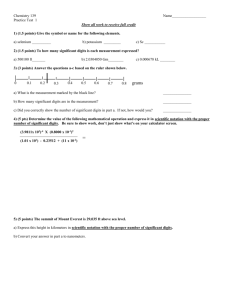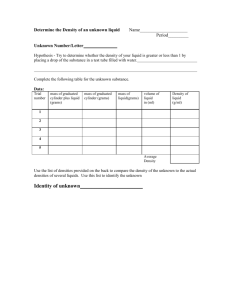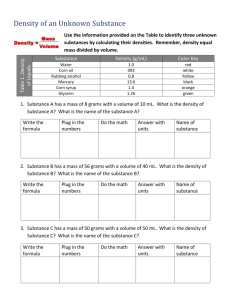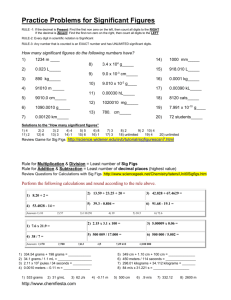PreAP Chemistry Prep Online Packet
advertisement
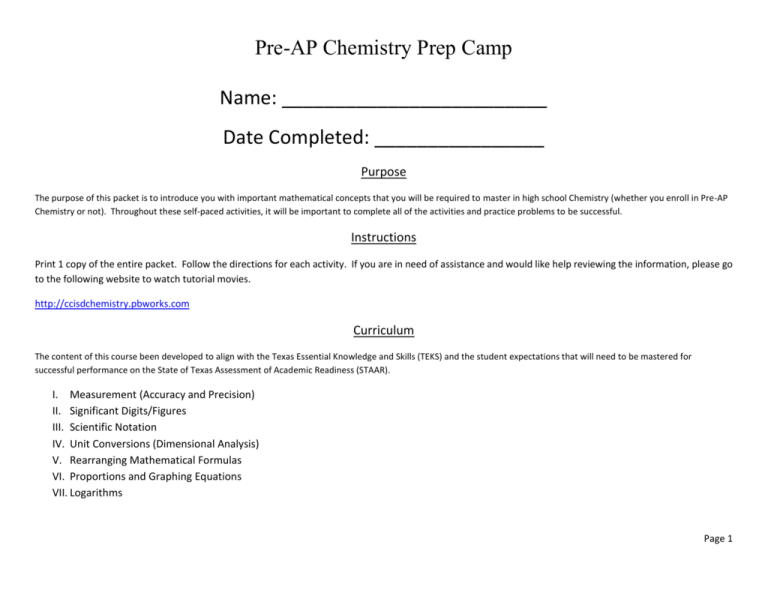
Pre-AP Chemistry Prep Camp Name: _________________________ Date Completed: ________________ Purpose The purpose of this packet is to introduce you with important mathematical concepts that you will be required to master in high school Chemistry (whether you enroll in Pre-AP Chemistry or not). Throughout these self-paced activities, it will be important to complete all of the activities and practice problems to be successful. Instructions Print 1 copy of the entire packet. Follow the directions for each activity. If you are in need of assistance and would like help reviewing the information, please go to the following website to watch tutorial movies. http://ccisdchemistry.pbworks.com Curriculum The content of this course been developed to align with the Texas Essential Knowledge and Skills (TEKS) and the student expectations that will need to be mastered for successful performance on the State of Texas Assessment of Academic Readiness (STAAR). I. Measurement (Accuracy and Precision) II. Significant Digits/Figures III. Scientific Notation IV. Unit Conversions (Dimensional Analysis) V. Rearranging Mathematical Formulas VI. Proportions and Graphing Equations VII. Logarithms Page 1 On your tablet or computer, please install a graphing calculator for future use. To do so, go to http://wabbit.codeplex.com 1. Download Wabbitemu 2. Run Wabbitemu.exe 3. Select “Create a ROM image” 4. Select Calculator Type TI-84 Plus SE using open source software 5. Select OS 2.55 MP 6. Save ROM file to “My documents” and name “Wabbitti84emulator” 7. From View menu, select Enable Skin 8. To close the calculator, go to File and Exit or “X” out. 9. If you are using a tablet, you may want to pin the calculator to your taskbar. Page 2 I. Measurement Go to the following website: http://ccisdchemistry.pbworks.com Download and review the “Units of Measure” Powerpoint. Answer the following problems. #1. ___________________ #2. ___________________ #3. ___________________ 42. ________________ 22. ________________ Explain why it’s important for scientists around the world to use the same system of measurement. ________________________________________________________________ ________________________________________________________________ ________________________________________________________________ ________________________________________________________________ ________________________________________________________________ ________________________________________________________________ ________________________________________________________________ ________________________________________________________________ Page 3 Activity A: Exploring Units of Measure Procedure: Name the appropriate instrument to measure the following items. Then, use instruments that you find at home to measure and record your results. 1. The length of a piece of paper in centimeters (cm) Equipment: ____________________________ Measurement: _________________________ 2. The volume of a book in cubic centimeters (cm3) Equipment: ____________________________ Measurement: _________________________ 3. The temperature of your body Equipment: ____________________________ Measurement: _________________________ 4. The pressure of a car’s tire Equipment: ____________________________ Measurement: _________________________ Page 4 II. Significant Digits/Figures Go to the following website: http://ccisdchemistry.pbworks.com Download and review the “Significant Digits” Powerpoint. Take notes on this page by filling in the blanks and completing the practice problems. Significant Digits Rules: 1. All non-zero digits are significant. 2. Zeros a. Leading Zeros - ____________________ significant b. Middle Zeros - ______________________ significant c. Trailing Zeros - ________________________ significant (Depends on the presence of a _______________________ ______________________) i. if decimal point is present: _____________________ significant ii. If decimal point is not present: __________________ significant Practice: How many significant digits are in the following numbers? a. b. c. d. e. 1234 0.023 890 91010 9010.0 f. 1090.0010 g. 0.00120 h. 3.4 x 104 i. 0.00390 j. 0.00030 k. l. m. n. o. 1020010 780. 1000 918.010 0.0001 Page 5 Calculations using significant digits: 1.Multiplication and Division: a. The number of significant digits in the answer should be equal to the number of significant digits in the least accurate factor. 2.Addition and Subtraction: a. The number of decimal places in the answer should be equal to the number of decimal places in the number with the fewest decimal places. *When performing calculations, you should do the calculation using all the digits allowed by the calculator and round off only at the end of the problem. Rounding in the middle can introduce errors. In your own words, define the following vocabulary words: Accuracy: _______________________________________________________________________________________________________ _______________________________________________________________________________________________________ _______________________________________________________________________________________________________ Precision: _______________________________________________________________________________________________________ _______________________________________________________________________________________________________ _______________________________________________________________________________________________________ Page 6 Activity B: Exploring Significant Digits Highlight (or color) all of the squares that have three significant digits. 6.050 0.04 8.300 300 75 37.40 7500 1.204 0.04 0.0500 2.0032 0.004 3.20 105 0.0670 0.280 210. 75.40 801.0 4.005 950 1230. 45.7 23.45 404 8.3 x 107 0.1240 0.43 500 98.73 703.0 23.00 10023 8.9 3.0 x 103 5.45 1.2 x 104 400.02 3.231 35.90 0.2950 0.003 12.50 90024 10.50 4.5 x 104 400. 65.0 0.100 750. 800056 2.30 7.80 3.03 90.6 850 8.760 0.4504 1.002 x 106 3.0 x 103 1.20 x 108 5.0042 0.0700 0.9850 4.0 103 3.007 1008 6.059 1060. 4.808 3.802 5.09 0.04 145 10.04 4.780 3005 3.3 3.400 1.02 x 108 345 540. 12.0 3800 5.00 900. 5.04 23.57 6060. 7.900 5.840 200.0 075 6003 99.08 700. 88.90 3450. 0.6540 2.300 850 76.30 1.0024 0.1350 3.0 x 107 9702 320. 9045 10.532 1.780 900 7.880 0.550 123.0 0.30 8003 210.7 0.0900 20.95 5 x 103 40020 0.2560 6.60 800.23 0.0050 324.0 9.566 2.070 0.23 1.001 7.100 30.80 802.0 Page 7 Activity C: Counting Significant Digits Using scissors, cut apart each square found on this page. Count the number of significant digits and glue into the appropriate column on the following page. 77.98 1.20 3000 1.429250 30.031 825.00 0.10 0.9003 5 x 1012 5701 7.5 609 0.26702 190.001 320.005 2400.5250 0.410020 0.06 4590118 165.3310 2.48 x 105 0.0053 0.9 57701 4.610 x 101 0.0032 10 x 10-3 0.0101 Page 8 Page 9 III. Scientific Notation: Go to the following website: http://ccisdchemistry.pbworks.com Download and review the “Scientific Notation” Powerpoint. Take notes on this page by filling in the blanks and completing the practice problems. Rules: Base number MUST be between ______ and ______. Numbers ___________ have a ___________ exponent. Numbers ___________ have a ___________ exponent. Never say “move decimal to the right” (or “to the left”) because it depends whether you are putting a number INTO scientific notation or taking it OUT OF scientific notation. This will just confuse you! To determine the number of significant digits, use the digits in the base number only. ***You will need to know how to enter scientific notation numbers into the calculator. This is VERY important. If you think you already know how to do it correctly, complete the following problem. If you get it correct, please move on. If you do not get the problem correct, please watch the “Using Scientific Notation with a Calculator ” movie found at http://ccisdchemistry.pbworks.com 31144 ÷ 6.8x103 = ____________ Correct Answer = 4.58 Incorrect Answer = 4580000 Page 10 Activity D: Memorizing Element Symbols Go to http://ccisdchemistry.pbworks.com. Download and print the Chemistry STAAR Periodic Table. Your teacher will be expecting you to memorize the following elements. Highlight each of these elements on the STAAR Periodic Table. You may want to make flashcards to help you begin to memorize the symbol for each element name. Arsenic Cesium Chlorine Chromium Copper Gold Iron Lead Magnesium Manganese Potassium Rubidium Silver Sodium Strontium Tin Vanadium Zinc Boron Carbon Fluorine Hydrogen Iodine Aluminum Argon Barium Beryllium Bromine Calcium Cobalt Francium Gallium Germanium Helium Krypton Lithium Neon Nickel Radium Scandium Selenium Silicon Titanium Nitrogen Oxygen Phosphorus Sulfur Uranium Page 11 Determining Significant Digits Any measurement is inaccurate to some degree. The inaccuracy stems from several factors. The precision of any measuring device is limited. The person doing the measurement may introduce error. The experimental technique may be faulty. Because a measurement contains some degree of inaccuracy, the number of digits that are valid for the measurement are also limited. How many significant digits are in the following measurements? 1. 2. 3. 4. 5. 23.30 cm 3.65 kg 365 kg 1843.02 L 8.701 °C 6. 2000.12 mm 7. 2.000 x 10 8. 0.5 mL 9. 704,000 h 10. 0.0001010450 s Complete these addition problems. Write the sum correctly using significant digit rules. 11. 3.414 + 10.02 + 58.325 + 0.0098 12. 1884 + 0.94 + 1.0 + 9.778 Complete these subtraction problems. Write the difference correctly using significant digit rules. 13. 2104.1 – 463.09 14. 2.326 – 0.10408 Complete these multiplication problems. Write the product correctly using significant digit rules. 15. (10.19) * (0.013) 16. (140.01) * (26.042) * (0.0159) Complete these division problems. Write the quotient correctly using significant digit rules. 17. (80.23) / (2.4) 18. (4.301) / (1.9) Page 12 Answer the following questions using all significant digit rules that are applicable. 19. An experiment calls for 16.156 grams of substance A, 28.2 grams of substance B, 0.0058 grams of substance C, and 9.44 grams of substance D. a. How many significant digits are there in each measurement? b. What is the total mass of substances in this experiment? c. How many significant digits should there be in the answer to part b? 20. Your lab partner has measured 16.50 mL of water. You accidentally tip over the graduated cylinder and spill some water. You stand the cylinder up, and determine that there are 8.0 mL left. a. Which measurement is more precise, your lab partner’s or yours? Explain. b. How much water did you lose when you tipped over the graduated cylinder? Page 13 Measuring Correctly in Chemistry: Go to the following website: http://ccisdchemistry.pbworks.com Download and watch the “How to Measure using Significant Digits” Movie. Record your answers to each of the questions in the blanks below. Remember: The number of significant digits in a measurement depends on the accuracy of the instrument. When measuring, there needs to be a 1-digit estimate in between the smallest increments. Every measurement must have a number and a unit. 1. 2. 3. 4. 5. _____________ _____________ _____________ _____________ _____________ 6. 7. 8. 9. 10. _____________ _____________ _____________ _____________ _____________ Page 14 Activity E: Measuring Mass Go to the following website: www.explorelearning.com Login using the following information. Username: CCISD613 Password: box619 Launch the “Triple Beam Balance” Gizmo. Apply the knowledge you have just learned to measure the mass of the items using the correct amount of significant digits. Record your answers below. Then answer the 5 multiple choice assessment questions. Mass of Cone: _____________________________ Mass of Lightbulb: _________________________ Mass of Paperclips: _________________________ Mass of Cube: ______________________________ Assessment Questions: 1. 2. 3. 4. 5. __________ __________ __________ __________ __________ Page 15 Activity F: Measuring Volume Go to the following website: www.explorelearning.com Login using the following information. Username: CCISD613 Password: box619 Launch the “Measuring Volume” Gizmo. Apply the knowledge you have just learned to measure the volume of the items using the correct amount of significant digits. Then answer the 5 multiple choice assessment questions. To begin, remove the 50-mL graduated cylinder from the cabinet and place it below the faucet. To turn on the faucet, click on the faucet handle. Fill the cylinder about halfway. Place the magnifier over the waterline. Draw a sketch of what you see in the area at right. Label the large tick marks on your sketch. This curved shape is called the meniscus. Always read the volume at the bottom of the meniscus. 1. Place the 250-mL beaker below the faucet and fill it with water. (Move the faucet handle up to pour faster.) You will use the beaker as a source of water in your experiments. 2. To pour water from the beaker to the graduated cylinder, move the beaker over the graduated cylinder. Add about 15 mL of water to the graduated cylinder (does not have to be exact). Place the magnifier over the waterline, and sketch what you see in the space at right. Label the large tick marks on your sketch. Page 16 3. Measure: Scientists use pipettes, also known as eyedroppers, to add or remove small amounts of water. To fill the pipette, place its tip in the beaker water and click the black bulb once. To release a small amount of water, place the pipette above the graduated cylinder and click the bulb. Do this until the graduated cylinder contains exactly 17.5 mL of water. (Remember to read the volume at the bottom of the meniscus.) Click the camera at upper left to take a screen shot. Open up a blank Microsoft Word document and paste in the screen shot. Label this image “17.5 mL.” When you are finished, you will print out this document and turn it in with this packet. Use the Gizmo to complete each of the following challenges. When you have finished each one, take a screen shot and add it to a Microsoft Word document. Label each image with the volume. When finished, print out the document and add it to your packet. A. Fill the 25-mL graduated cylinder with 11.5 mL of water. B. Fill the 100-mL graduated cylinder with 76.0 mL of water. C. Fill the 50-mL graduated cylinder with 38.5 mL of water. 4. Suppose you needed to measure exactly 15.0 mL of water for an experiment. Which graduated cylinder would be the best one to use, and why? _________________________________________________________________ _________________________________________________________________ _________________________________________________________________ _________________________________________________________________ _________________________________________________________________ 5. Using the Ruler, find the volume of Rectangular Prism. (V = l x w x h) Length: _______________ Width: _________________ Height: _________________ What is the volume of the rectangular prism? ______________________________________________ Page 17 6. Using water displacement, find the volume of the rock. (Hint: For a more precise measurement, use the 25-mL graduated cylinder.) What is the volume of the rock? __________ Describe how you found the rock’s volume. ________________________________________________________________ ________________________________________________________________ ________________________________________________________________ ________________________________________________________________ ________________________________________________________________ 7. What is the volume of the Large Sphere? ____________________ 8. What is the volume of the marble? _________________________ Assessment Questions: 1. 2. 3. 4. 5. __________ __________ __________ __________ __________ Page 18 IV. Unit Conversion (Dimensional Analysis) 1. Suppose they gave us 0.024 miles and wanted to know how many inches it was. a. We begin with what they gave us .024 miles b. Next we find on our conversion sheet something we can convert miles to. There is only one conversion that is given and that is miles kilometers Since miles is on top of our first line, it must go on bottom next in order to cancel out. .024 miles 1 km 0.62 miles c. The miles cancel and leave us with km. But we aren’t done, as we are wanting to go to inches and currently we have km. So since km is on top, we have to put it on bottom, and to get us closer to inches we are going to change our km into meters .024 miles 1 km 0.62 miles 1000 m 1 km d. Kilometers now cancel and leave us with meters. Now we can change our meters into inches .024 miles 1 km 1000 m 39.37 in 0.62 miles 1 km 1m e. Now we are ready to plug this into our calculators. We start off with the first number which is 0.024, then since 0.62 is on bottom we divide by it, since 1000 is on top we multiply by it, and since 39.37 is on top we multiply by it. So in our calculator we put in 0.024/0.62 x 1000 x 39.37 = (We ignore the 1’s since it doesn’t do anything mathematically.) f. The answer that we get is 1524. Remember, we must use our significant digit rules for multiplication, followed by assigning appropriate units. Our final answer is 1500 in. 2. So that is how you do simple configurations. Let’s assume though that we had a complex or double unit. Miles per hour, gal per minute, and meters per second are all examples of this. a. So let’s say that we had 75 miles per hour. They are wanting to know how many feet per second this is. Per is just another way of saying divided by. So we start with what they give us 75 miles 1 hr 1 km 1000 m 3.28 ft 1 hr 1 min 0.62 mi 1 km 1m 60 min 60 seconds b. We solve this the same way. 75/.62 x 1000 x 3.28/60/60 = 110.22 ft/sec Page 19 Helpful Conversion Factors Use these conversion factors to help you convert from one unit to another. You will not need to memorize these conversion factors. Length: 100 centimeters (cm) = 1 meter (m) Volume: 1000 millimeters (mm) = 1 meter 1000 milliliters (mL) = 1 L 2.54 centimeters = 1 inch (in) 1 liter = 1.06 quarts 1000 meters = 1 kilometer (km) 1 cubic centimeter = 1 milliliter 1 kilometer = 0.62 miles (mi) 4 Quarts (qt) = 1 gallon (gal) 1 yard = 3 feet 1 quart = 2 pints Mass: 1 pint = 473 mL 1000 grams (g) = 1 kilogram (kg) 1 pint = 2 cups 1 gram = 1000 milligrams (mg) 1 cup = 8 fluid oz. 1 gram = 100 centigrams (cg) 3.79 L = 1 gallon (gal) 1 gram = 0.035 ounces (oz) 1 pound = 454 grams 1 kilogram = 2.20 pounds (lbs) ***If needed for these introductory purposes, please assume that: 1 gram = 1 mL 2000 pounds = 1 ton Page 20 Unit Conversions Practice Problems: Remember, if you need help understanding how to convert units, please go to http://ccisdchemistry.pbworks.com to watch a movie. 1. How many mg are in 24 grams? 2. How many centimeters in 10 inches? 3. Convert 45 inches to centimeters 4. A doctor tells a patient to take 30 mL of a medicine. How many teaspoons of the medicine should she take? 5. Convert 23 miles to inches. Page 21 Activity G: How much does it really cost? Go to ccisdchemistry.pbworks.com Download the HEB Grocery Store Advertisement Prices to help you answer the following questions. Compare the prices of each item. 1. Name of item: Hellmann’s Real Mayonnaise Price: ______________ Volume of item: ______________________ Price per gallon: ___________________ (total price/gallons) Convert the volume of this item to gallons. 1. Name of item: Formula 409 All Purpose Trigger Spray Cleaner Price: ______________ Volume of item: ______________________ Price per gallon: ___________________ (total price/gallons) Volume of item: ______________________ Price per gallon: ___________________ (total price/gallons) Convert the volume of this item to gallons. 2. Name of item: Hill Country Fare Peanut Butter Price: ______________ Convert the volume of this item to gallons. Page 22 3. Name of item: Central Market Organics Milk Price: ______________ Volume of item: ______________________ Price per gallon: ___________________ (total price/gallons) Convert the volume of this item to gallons. 4. Name of item: Febreeze Air Effects Air Freshener Price: ______________ Volume of item: ______________________ Price per gallon: ___________________ (total price/gallons) Convert the volume of this item to gallons. 5. What is the current price for gasoline? Price per gallon: __________________ 6. Name the most expensive item on our grocery list. ________________________ 7. What is the most expensive item per gallon? ________________________ 8. Why is it important to compare items using the same unit? ______________________________________________________________ ______________________________________________________________ ______________________________________________________________ Page 23 CHALLENGE PROBLEM Complex Units: Treat the numerator unit first, then go back and do the denominator unit. If you need help, please watch the “Converting Complex Units” movie at http://cisdchemistry.pbworks.com Which object is travelling faster? 15 miles per hour OR 600 centimeters per second Page 24 Converting Complex Units Practice: 1. Jane is studying the scene of a car accident. According to the driver, he was going 56 miles per hour when he slammed on his brakes. Jane needs to know how many feet per second this is. Convert. 2. Dolly is trying to catch up with a group of stampeding cattle. She remembers from her biology class that cattle can run at a speed of 22 miles per hour. She also knows that her old horse, Silver, runs at a speed of 20 feet per second. What is the speed of Silver in miles per hour? Is she able to catch up with the stampede? 3. Bobby Joe’s restaurant has two working toilets. Together they are flushed about 146 times a day. If each flush uses 2.54 gallons, and a gallon of water costs $0.15, how much is Bobby Joe spending on water per year? We are assuming they are open every day of the year. 4. Fingernails grow at a rate of 0.14 millimeters per day. If Freddy let his fingernails grow for a year, how long would they be in inches? Page 25 Activity H: Converting Units Lab Sucrose Lactose NaCl Benzoyl Ecgoninex Vanillin Mixed Esters 7.5 cups = 2 lbs powdered sugar 0.97 grams sucrose = 1 gram powdered sugar 454 grams = 1lb 0.0464 grams Lactose = 1 gram milk 1.59 grams milk = 1 mL milk 1 mL = 0.068 Tbsp. 2.165 grams NaCl = 1 mL NaCl 1 mL = 0.20 tsp 1 pinch = .07 tsp 226 grams cocoa = 1 cup cocoa 0.01 grams Benzoyl Ecgoninex = 1 gram cocoa 7 Tbsp = 0.5 cups cocoa 1.056 grams vanilla extract = 1 mL vanilla extract 0.275 grams vanillan = 1 gram vanilla extract 1 tsp = 5 mL 8 Tbsp = 4 oz 454 grams = 1 lb 16 oz = 1 lb 1 gram Mixed Ester = 1 gram margarine Convert each ingredient to English units (cups, teaspoons, etc.) using the conversion factors found in the table above. When you are finished, combine the ingredients in a pot and boil for 5 minutes. Add ½ cup of mini marshmallows and then pour into a pan and let cool to room temperature. When you are finished with the entire Mini Math packet, reward yourself for all of your hard work by eating a piece of your lab experiment! Page 26 A. 236 grams of sucrose (C12H22O11) = _________________________ cups of powdered sugar B. 0.6474 grams of Benzoyl Ecgoninex = __________________________ Tbsp of cocoa C. 0.774 grams of NaCl = _______________________ pinches of salt D. 56.75 grams of mixed esters = ____________________ Tbsp margarine E. 4.34 grams of lactose = __________________________ Tbsps of milk F. 1.452 grams of Vanillin = ___________________________ tsp vanilla extract Page 27 V. Rearranging Mathematical Formulas Go to http://ccisdchemistry.pbworks.com. Download and print the Chemistry STAAR Formula Chart. In each of the questions below, there is an important chemistry formula. Find each of the formulas on the STAAR Formula Chart and highlight them. Then, re-arrange each formula to solve for the unknown variable. 1. Rearrange the equation for area of a rectangle (A = l x w) to solve for l. 2. Rearrange the equation for density (𝑑 = 𝑚 v ) to solve for volume, v. 3. Rearrange the equation for the Ideal Gas Law (PV = nRT) to solve for number of moles, n. 4. Rearrange the equation relating energy to specific heat capacity (Q=m∙c∙∆T) to solve for a change in temperature ∆T. 5. Rearrange the Combined Gas Law equation ( 𝑃1 𝑉1 𝑛1 𝑇1 = 𝑃2 𝑉2 𝑛2 𝑇2 ) to solve for the final temperature, T2. Page 28 Activity J: Proportions and Graphs Using scissors, cut apart each square found on this page. Then glue each square into the appropriate column on the following page. Page 29 VI. Proportions and Graphing Equations Direct Inverse Quadratic Exponential Page 30 VII. Logarithms Go to the following website: http://ccisdchemistry.pbworks.com Download and watch the “Logarithms” Movie. ***To calculate the logarithm of a number, you will need to use a scientific calculator. In class, a graphing calculator will be provided for you to use. However, you will not have access to the calculator outside of class for homework. If you do not have access to a scientific calculator at home, please go to the following website. www.ecalc.com Record your answers to each of the questions in the blanks below. Example Problems: 1. – log (0.001) = 3. – log (1 x 10-5) = 2. – log (0.000000001) = 4. – log (0.0025) = Example Problems (working backwards): 5. – log (x) = 4.00 6. – log (x) = 5.6 *** Remember: Significant Digit Rules. For any log, the number to the left of the decimal point is called the characteristic, and the number to the right of the decimal point is called the mantissa. The characteristic (the numbers to the left of the decimal point) do not count as significant digits. Page 31
